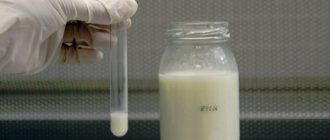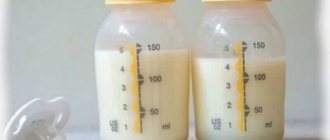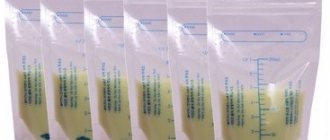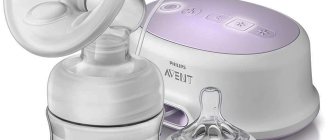What do foremilk and hindmilk mean?
Foremilk and hindmilk are not different types of milk , but 2 terms that describe the nutritional fluid at the beginning/end of a feeding. There is no clear distinction between foremilk and hindmilk. The characteristic changes gradually from the moment of influx of nutrient fluid during the next episode of lactation.
Properties and color of fore and hind milk:
- The anterior one is bluish, translucent, more watery. Rich in lactose (milk sugar), minerals, protein compounds. A portion of foremilk provides the baby with the necessary fluid.
- The back is white or yellowish, thick. It contains higher amounts of fats, fat-soluble enzymes, growth factors and sleep factors.
A nursing woman finds it difficult to determine the fat content of milk by its appearance. Even a dairy product with a liquid consistency can be nutritious and satisfying. When the baby suckles at the breast, he first receives a portion of foremilk, and then gradually the hindmilk with a high fat content comes in. The mature product reaches the baby faster when it is frequently applied to the maternal glands.
How to regulate the amount of foremilk your baby consumes
Unfortunately, no one can say when foremilk ends and hindmilk begins. But the more and longer the baby suckles, the more satisfying his lunch will be. If the mother notices that the baby is not eating enough or that urination has become more frequent, this may be a sign that the baby has not reached the fatty milk. Also, a large amount of liquid milk in a newborn’s diet can cause colic, gas formation, changes in stool or its absence.
In order for your baby to eat nutritiously, it is necessary to properly establish a feeding schedule. In this case, pediatricians recommend that mothers change breasts no more than once every 2 hours. If necessary, a little foremilk can be expressed so that the baby quickly reaches hindmilk. To speed up the filling of the breast with fatty milk before feeding, you can massage it a little, so that during the tide the fatty particles are more easily separated from the walls of the ducts. In addition, this can also prevent inflammatory processes in the mother's breast.
Why does separation occur?
Milk accumulates in the mammary glands until the newborn shows interest in them. It collects in the alveoli, ducts, and milky sinuses. Fat particles stick to microscopic bubbles in the upper part of the breast. And the low-fat nutrient liquid flows down.
The low-fat portion fills the cavities of the mammary gland, first entering the newborn’s mouth. Before the primary flush, foremilk always comes in. As the breast empties, fat particles move from their place, heading through the milk ducts to the nipple. The longer the lactation process goes on, the more fatty liquid comes from the gland. This occurs against the backdrop of increasing displacement of fat particles.
The division into the mother's fore/hind milk is considered conditional. The composition of the nutrient fluid changes with each episode of lactation.
How to understand what kind of milk your baby drinks
When figuring out how to tell if a baby is eating hind milk, many mothers feel desperate. Some babies don't have the patience to nurse for long periods of time, or the parent's schedule doesn't allow for breastfeeding often enough. For example, Komarovsky recommends partial pumping. There are no clear instructions on whether or how to express hindmilk. With the help of pumping, you can reduce the separation of colostrum and improve the quality of feedings.
When answering the question of how to understand that hindmilk is coming in and that the baby is feeding on it, you should observe the condition of the baby:
- The child behaves calmly, regularly gains weight according to norms, and is not capricious;
- The baby sleeps well and does not show dissatisfaction after feedings;
- The baby's stool looks normal and the baby is not constipated or has diarrhea.
Based on these signs, you can understand that the baby sucks out hind milk regularly, eats enough and gets enough useful elements.
How to determine the imbalance of fore and hind milk
During lactation, an imbalance of foremilk and hindmilk sometimes occurs. This condition is indicated by the following symptoms:
- the baby behaves restlessly while eating;
- the child often spits up after eating;
- baby's stool is liquid and foamy;
- the newborn is capricious from increased flatulence and intestinal colic;
- the child is not gaining weight well.
This phenomenon is associated with the fact that the baby eats a lot of watery milk, but does not get the hind milk. This happens not because of problems with the mother’s nutritional product, but because of the baby’s chaotic attachment to the gland.
If the mammary gland has stopped filling between episodes of breastfeeding, then this is not a reason to panic. This is often associated with the physiological establishment of lactation. The nutritional product begins to be produced when the infant suckles. Liquid will accumulate only during long breaks in breastfeeding.
If your baby is too lazy to eat hind milk
Often a newborn is lazy to suck out the posterior nutrient fluid, limiting himself only to the anterior one. This is due to the fact that foremilk flows easily into the baby's mouth without any effort on his part. And in order to suck out the fatter mature one, you need to work hard. More lazy people are born, and fewer hard workers.
If a nursing mother begins to notice this trend, she can take the following measures:
- Do not change the mammary gland for 2-3 hours. Starting with the right/left breast, the baby should suckle until it is completely empty.
- Having drunk a portion of the front liquid, the baby no longer wants to seek the back one. He begins to act up, twist his head, and pull on his nipple. The mother continues to persistently give to the chosen breast until the milk in it completely disappears.
The mother should not force the nipple into the baby's mouth. While the newborn is capricious, he is distracted by games or rocking. The calmed newborn is given breastfeeding again.
A diligent baby, when the breast is completely emptied at the end of feeding, receives a large portion of mature milk.
Myths about breast milk
In search of information on how to express hind milk if the baby is not eating enough or is not gaining weight well, women resort to various methods of improving the quality of colostrum.
This is how myths about breastfeeding and milk in general are born:
- A woman's diet does not affect the fat content of breast colostrum. Throughout the day and from feeding to feeding, the fat content of the milk changes naturally to ensure that your baby gets the right amount of calories.
- Some women believe that the milk supply depleted during the day leads to the fact that the baby does not get enough to eat. In fact, by evening, the richest cream remains in the mammary glands, which the baby will eat even in small quantities.
- Mothers also wonder what to do in the morning. In the morning feeding, the baby receives the least amount of calories. In fact, there is no need to track the calorie and fat content of food at each feeding. It is important that the baby receives enough fat throughout the day, and not just one meal.
- It may seem to a woman that the baby is too lazy to suck out hind milk. This is wrong. The baby eats a natural amount of food and comes off the breast when full. The more natural breastfeeding is, the healthier the baby’s diet will be.
If the mother does not have the physical ability to frequently latch her baby to the breast, you can look for how to express hind milk with a breast pump. By expressing a large amount of liquid, you can achieve the presence of a significant proportion of posterior colostrum in the composition.
How to feed
Frequent feeding of the newborn to the breast provides him with the most uniform nutrition. The resulting liquid will be uniformly fatty and nutritious. The newborn will not feel much of a transition from watery to mature. If lactation occurs once every 2-2.5 hours, then the nutrient fluid becomes fatty as the lactation process progresses.
It is important to ensure that the baby sucks completely from the breast. Otherwise, hindmilk may not reach the baby. Both types of nutritional fluid should be well absorbed by the newborn. Natural lactation will be beneficial for the baby if the woman understands all the nuances of this issue.
Correct application
If the nipple is latched on incorrectly, the risk of not receiving hindmilk increases. The mother must ensure that the baby is properly attached to the breast:
- The head and body are located on the same line. The body is pressed against the mother at a right angle.
- The baby's face is turned towards the mammary gland, and the nose is towards the nipple. A position that is comfortable for both is selected.
- The head is thrown back and the mouth is wide open. They bring the baby to the breast, and not vice versa.
- It grabs the nipple, the isola, and partially the surrounding gland tissue with its mouth. Infants who try to suck the tip of the nipple with the tips of their lips remain hungry and also cause pain to the mother.
- The nose is pressed tightly to the mammary gland, but is not recessed into it. There are no extraneous sounds in the process, except for sips. The woman does not experience discomfort or unpleasant sensations.
Even before the maternity hospital, the expectant mother must master proper attachment in order to feed the baby correctly from the first days. If a woman is determined to breastfeed, then she should not give her newborn an artificial formula in the maternity hospital. The bottles are equipped with comfortable nipples with large holes, suitable for lazy children. Breasts quickly feel the difference. They choose bottles, abandoning the natural way of eating.
Night feedings
Stimulation of uniform milk production occurs best with night feedings. If babies sleep peacefully all night, the mother's milk will disappear faster. Sometimes the baby falls asleep with the nipple in his mouth and periodically sucks on it even while dozing. There is no need to take the breast away from him - this way he will not get enough of the posterior nutrient fluid.
The age and individual characteristics of children affect the frequency of feedings. Breastfeeding requires frequent nighttime lactation. Closer to 6 months, they sleep longer at night. In older children, the need for sucking shifts to the second half of the night, closer to the morning.
A well-fed child releases the gland on his own, continuing to sleep peacefully.
Breast change
When eating, the baby must empty 1 gland. It is not changed for at least 2 hours. And with a new episode of feeding, he will be offered a second filled gland. Children are sometimes capricious and refuse to take the nipple. Insisting in this case is inappropriate. After 15-20 minutes, when the baby calms down, he is given the same gland again.
In case of acute lack of nutritional fluid, the baby immediately moves to the second after the first mammary gland. This will help the woman stimulate her body to produce more nutrient fluid. If the baby is fully saturated with one gland, this should not be done.
The main reasons for deterioration of lactation:
- large gaps between feedings of the baby;
- irregular breastfeeding;
- the baby is weakened, sucks sluggishly;
- a lactating woman experiences stress;
- inflammatory diseases of the mammary gland.
Lactation stabilizes when unfavorable factors are eliminated. If a nursing mother has experienced a great shock or pain, then the following will help her restore the flow of milk: special breathing exercises, calm deep breathing, taking a warm bath with the baby, doing something we love, or a delicious lunch.
Pumping
Many nursing mothers express foremilk in order to ensure that the newborn quickly transitions to a portion of mature food. It is a mistake to use such tactics. Foremilk is rich in fast carbohydrates. Gives the baby the strength and energy necessary for growth, development, and motor activity. It also normalizes water balance.
When using a breast pump, a mother cannot always distinguish between fore and hind milk. A hungry baby will cope with the task better than any device. Pumping is resorted to when there is a threat of blockage of the ducts and the development of mastitis. For medical reasons, the woman expresses all the milk and feeds it to the baby from a bottle.
Before feeding, some mothers shake their breasts. This is due to the common belief that such manipulation allows the milk to become more homogeneous. GW specialists consider this unnecessary. But if a woman performs such a manipulation, then it is important to do this carefully, without pain or discomfort to the glands.
Duration of feeding
There are no clear boundaries regarding the duration of feeding. It depends on the individual abilities and needs of the baby. A healthy newborn breastfeeds for at least 30 minutes. This indicator is individual for each baby.
Active workers are not lazy to suck, so they quickly fill up and release the mammary gland. Other babies suckle slowly, falling asleep in the process. But they are activated if you try to remove the nipple. To resume active feeding, slightly remove the nipple or touch it on the cheek.
Typically, at the beginning of lactation, the baby is fed up to 10 times a day. As the child grows, the feeding schedule is reduced to 7-8 times per day.
Feeding mode
Pediatricians and neonatologists continue to debate about feeding regimens. Some insist that a schedule is mandatory. Others advise giving the newborn the breast when he asks for it. But in case of any concern, it is inappropriate to impose it. Whims can be associated with temperature discomfort, a dirty diaper, or a desire to attract attention.
The interval between lactations can range from a quarter of an hour to 2-3 hours. Regularity in requirements is usually established by 2-3 months. A nursing woman easily recognizes this and successfully adapts to it.
Common mistakes
During breastfeeding, women often make similar mistakes:
- Some wash the mammary glands (the norm is 1-2 times a day). With frequent hygiene procedures, the protective lubricant is washed off, protecting against the proliferation of pathogenic microorganisms.
- Hold your breasts with your hands while feeding. Such actions provoke lactostasis, which significantly impairs further full lactation.
- During feeding, they are distracted by TV, computer, mobile phone or other extraneous stimuli. This breaks the bond between mother and baby.
- They refuse breastfeeding and switch to artificial formulas if cracked nipples or a cold appear. For painless feeding, it is correct to use special silicone nipple covers. The baby will not catch a cold from the mother if she wears a protective mask.
Young mothers make other mistakes during lactation. A nursing woman should discuss unclear issues with a gynecologist or pediatrician. By being patient and following the advice of breastfeeding consultants, the mother will cope with the first difficulties that accompany the feeding process.
Forward and hind breast milk are equally important for the growth and development of the baby. With proper lactation, the baby gains weight well, is less capricious, and does not experience an unjustified feeling of hunger. Breastfeeding not only makes children healthier, but also creates a close relationship with the mother.











